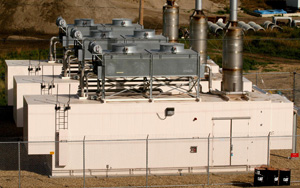Capital Power’s Power House
 Capital Power’s Clover Bar Landfill Gas facility sits alongside the Edmonton Waste Management Centre in the city’s northeast. The two are natural partners.
Capital Power’s Clover Bar Landfill Gas facility sits alongside the Edmonton Waste Management Centre in the city’s northeast. The two are natural partners.
For the last couple of decades, they have been working together to ensure that a potent gas resulting from decomposing organic material is appropriately managed.
“When landfill materials are covered with vegetation and deprived of air, methane gas forms,” explains Michael Taylor, Plant Manager at the Clover Bar Energy Centre. “This product is highly combustible so it is important to ensure that the gas doesn’t build up.”
Initially, pipes were driven deep into the landfill mound and the unpleasant smelling gas was vented directly into the air. City trained ‘nasal rangers’ patrolled adjacent communities in an attempt to identify and manage any drifting odours.
In the early nineties, when climate change and global warming became hot topics, the venting process evolved further to incorporate flaming the methane. This was thought to reduce potential environmental impacts.
By 2005, EPCOR, which spun off its generation assets to Capital Power in 2009, had decided it could do more, both for the environment and the community by constructing smaller generators at the site.
 “We invested in new infrastructure that would enable us to collect methane, run it through reciprocating engines and make electricity,” says Taylor.
“We invested in new infrastructure that would enable us to collect methane, run it through reciprocating engines and make electricity,” says Taylor.
The methane now travels through an extensive network of wells and PVC piping in the decomposing heap before it reaches the facility’s generating vents.
Although the Clover Bar Landfill Gas facility is no bigger than a neighbourhood home with an attached garage, it is a true powerhouse.
“Our generators create 4,800 kW of power for every hour that they run,” says Taylor. “That’s enough energy to power 4,600 homes annually.”
The facility is also reducing its carbon footprint by making use of the methane, a greenhouse gas that is 21 times more powerful than carbon dioxide.
Capital Power is harnessing the energy of something that would otherwise be polluting the atmosphere and earning carbon credits the whole time.
“In Alberta, we have comprehensive regulations that require large facilities to reduce greenhouse gas emissions,” explains Taylor. “Companies are charged $15 for every tonne over their mandatory reduction target.”
The Alberta Offset Program allows companies to accrue carbon credits. These credits must be registered with the province before they can be ‘retired’ – meaning that they have been deducted from any emissions charges that have been incurred.
 “The carbon credits we generate at the Clover Bar Landfill Gas facility are split with the City of Edmonton,” says Taylor. “We apply our share to balance out emissions from our larger coalfired and natural gas plants.”
“The carbon credits we generate at the Clover Bar Landfill Gas facility are split with the City of Edmonton,” says Taylor. “We apply our share to balance out emissions from our larger coalfired and natural gas plants.”
Good performers also have the option to sell their registered carbon credits.
“As a company, we end up in a positive position most years and have the opportunity to help others,” he says. “The program is great because it provides an economic incentive for those who are not performing as well to improve.”
As a member of the Strathcona Industrial Association (SIA), Capital Power is committed to environmental performance, safety and community wellbeing. Together, SIA members are ensuring heavy industry operators not only lead with responsible and sustainable policies and practices, but that they act as environmental stewards at every step of the way. SIA is greening our capital region.
Member Stories
- Keyera’s Alberta EnviroFuels Facility a Soaring Success
- Kinder Morgan Canada Targets Weeds
- Waste Management Centre Builds on Success
- EPCOR and Biosolids
- Capital Power’s Power House
- Recycling is AltaSteel’s Business
- Suncor Taps Into Waste Water
- Enbridge Steps It Up
- Rio Tinto Alcan Transforms Waste
- Owens Corning Builds a Brighter Future
- Imperial Oil Looks Ahead
- Small Product, Big Impact
- Imperial Strathcona: Paving the Way
